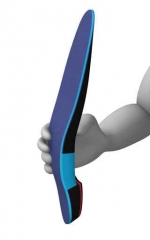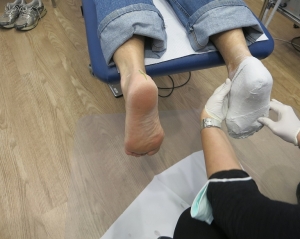Why you should know custom prescription orthotics from preformed and insoles.
These days the term “Foot Orthotics” is widely applied to anything is inserted into a shoe. It has been adopted by clever marketers to sell simple and moulded insoles. Unfortunately, this bundles together a group of devices that are very different in design, structure and anticipated function.
There are broadly 3 groups of devices that go into shoes- insoles, preformed orthotics and custom prescription orthotics.
Insoles are simple shoe liners that are worn inside a shoe. They tend to be flat, with a small amount of padding or cushioning incorporated into the design.
Preformed orthotics are a moulded device that should fit the curves of the foot and should provide the needed support and motion control. A simple version of these can be found in pharmacies and shoe stores; their materials tend to be softer and there will be less support compared to the ones that a podiatrist uses. Preforms used by podiatrists are more specialised to foot type and activities, and can be manually adjusted by the podiatrists if required.
Prescription Custom orthotics (orthoses) are devices that are made just for your feet from scratch. To make these Podiatrists conduct a comprehensive biomechanics and gait examination. A plaster cast (or some podiatrist use a 3D laser scan) is taken of your feet and then these casts are sent to an orthotic laboratory. The lab uses the plaster moulds to make wooden moulds of your feet, and then an orthotic material is vacuum pressed to the moulds. The lab technicians then shape the orthotic shell by hand and applies any additional features as per the prescription.
It becomes a case of PATIENT BEWARE when purchasing foot orthoses. Beware of purchasing from a retail store a one style suits all device. Beware of selecting your own device based on your symptoms, many conditions share symptoms but have very different origins. Beware of a health practitioner selling you a preformed orthotic from a limited stock or style. In all likelihood, this is an upsell technique for the practitioner designed to increase revenue. Beware of health practitioners who ask you to walk over a pressure mat to “scan” your footprint to make orthotics. Pressure is only one part of the biomechanical and gait equation, and cannot replace a 3D foot representation. This technique is often used by health practitioners who have a little knowledge, but not enough to know the shortfall of relying on technology instead of a thorough examination and plaster casts or 3D scan of the feet.
There is a reason the majority of Private of Health Insurers will only rebate on orthotics provided by a Podiatrist. Podiatrists have the comprehensive formal training required to understand the foot biomechanics and gait, and they can determine the correct device needed for each individual patient.
The Pod behind the Blog
Corrina Petric: Podiatrist, small business owner, mother, volunteer
Aspiring to Inspire

